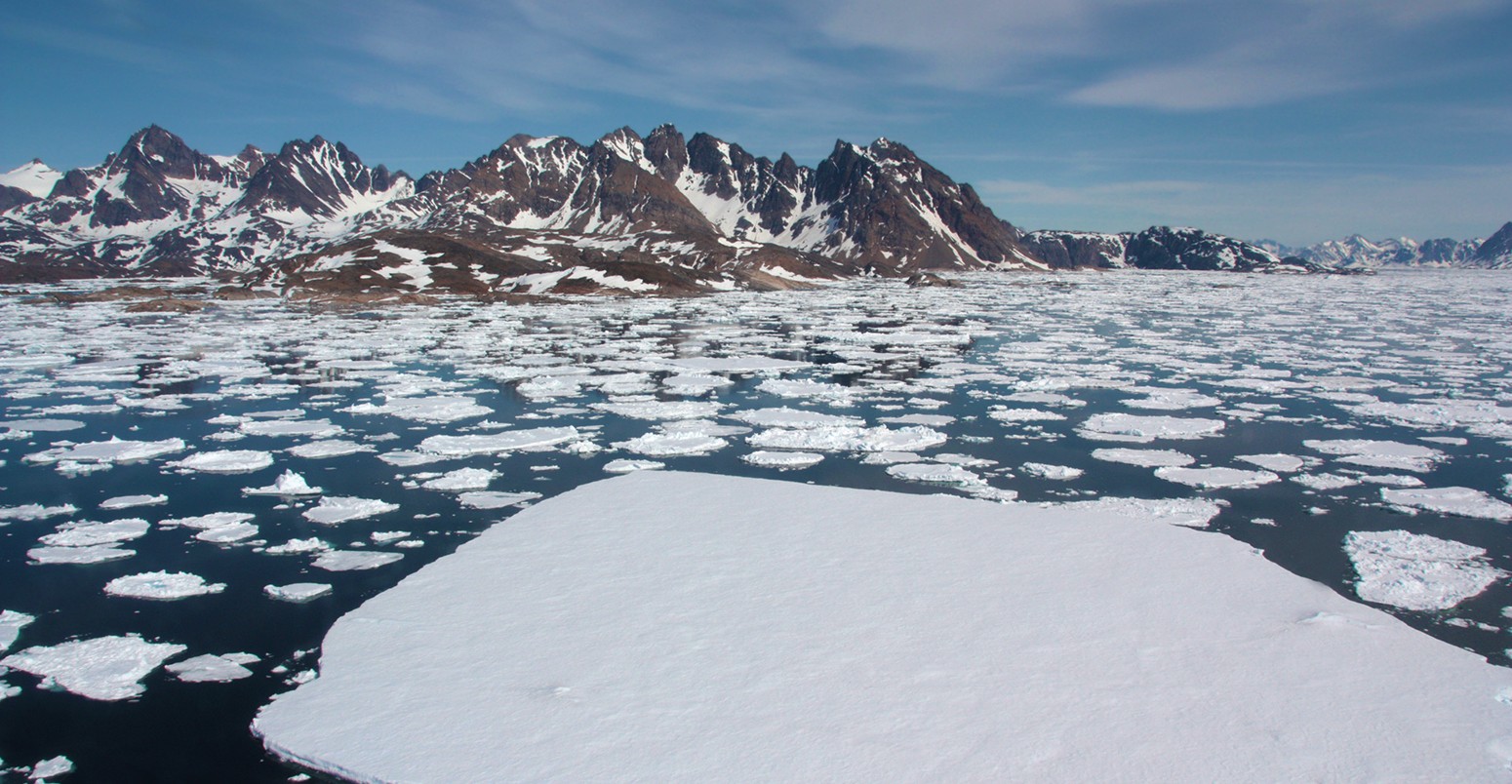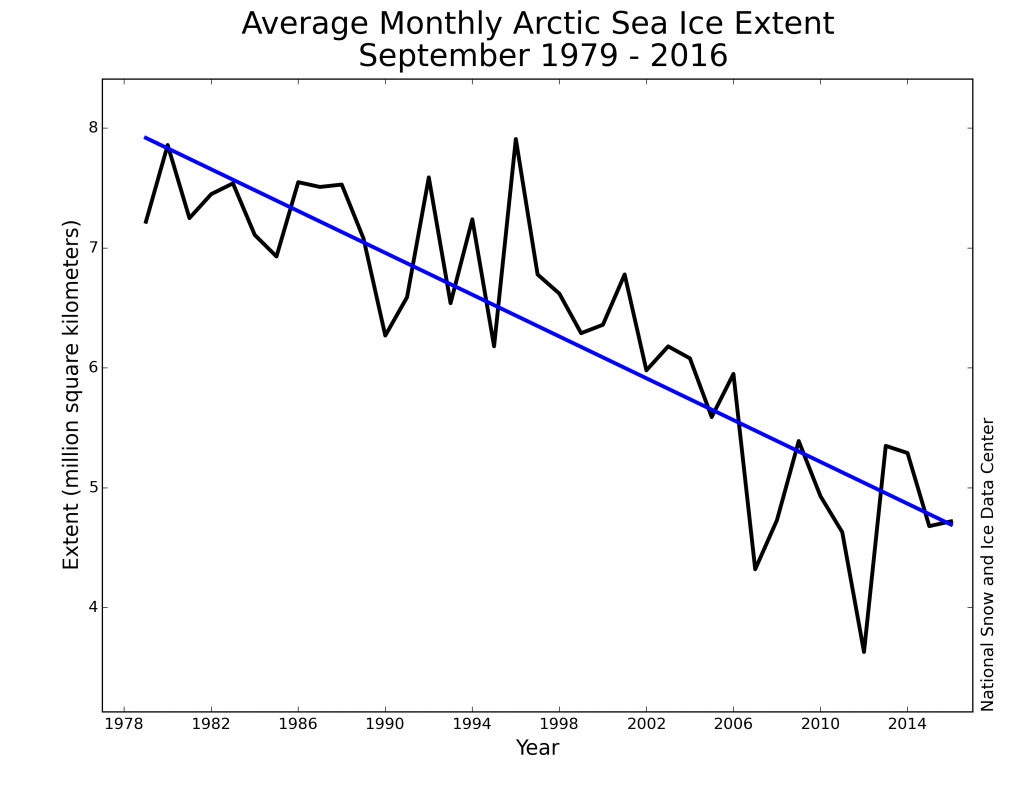
Humans causing up to two-thirds of Arctic summer sea ice loss, study confirms
Roz Pidcock
03.13.17Roz Pidcock
13.03.2017 | 4:04pmRising greenhouse gas emissions are responsible for at least half, possibly up to two-thirds, of the drop in summer sea ice in the Arctic since the late 1970s, according to new research. The remaining contribution is the result of natural fluctuations, say the authors.
The paper, published today in Nature Climate Change, confirms previous studies which show how random variations in the climate have acted to enhance ice loss caused by rising CO2.
Importantly, the authors state clearly in the paper that their work does not absolve human activity as a driver of Arctic sea ice loss. A News and Views article that accompanies the paper, by Dr Neil Swart from Environment and Climate Change Canada, adds:
“The results of Ding et al. do not call into question whether human-induced warming has led to Arctic sea-ice decline — a wide range of evidence shows that it has.”
Shifting patterns
With temperatures rising at more than twice the speed of the rest of the globe, the Arctic is the fastest warming place on Earth.
Arctic sea ice extent is declining in every season, but particularly quickly in September, when the ice reaches its lowest extent for the year. Since the beginning of the satellite record in 1979, Arctic sea ice cover in September has decreased by around 13% per decade.

Average Arctic sea ice extent for the month of September between 1979 and 2016. Black line shows annual data, and blue line shows the long-term trend. Credit: NSIDC
Scientists know the shrinking of Arctic sea ice is, in part, down to greenhouse gases warming the atmosphere and ocean. Today’s study suggests natural factors may have contributed between 30-50% of the decline since 1979, by changing the way air circulates in the Arctic region.
The authors point to stronger summer circulation over Greenland and the Arctic Ocean in areas where sea ice loss in September is highest. The Beaufort, Chukchi and East Siberian Seas have together experienced an average decline of more than 10% per decade, the paper notes.
The changes in atmospheric circulation in the Arctic, thought to originate in the tropical Pacific, increase the amount of water vapour in the lower atmosphere, the paper explains. Together with a shift to fewer clouds, this has increased the amount of solar radiation reaching the ice.
Human contribution
In many ways, the new study is unsurprising since scientists already know that natural variability is driving some of the long-term trend, notes Dr Ed Blockley, polar climate manager at the Met Office Hadley Centre, who wasn’t involved in the study. He says:
“It has long been known that the observed decline in Arctic sea ice, caused by global warming, is also being enhanced by the influence of natural variability in the climate system.”
Neither is the new study surprising in the size of the contribution it attributes to natural variability, says Prof Julienne Stroeve, professor of polar observation and modelling at University College London. She tells Carbon Brief.
“Several papers, including those published by myself, have shown that 50-60% of the ice loss is a result of greenhouse gases, leaving the other 40-50% from natural climate variability.”
The authors themselves say in the paper that their result is “perhaps not surprising” given past estimates that have come up with a similar ball-park figure for the role of natural variability.
The paper is, perhaps, useful in adding more detail to the evolving picture of Arctic sea ice loss, says Dr Twila Moon, a lecturer in cryospheric sciences at the University of Bristol. She says:
“This well-designed study provides the best detail yet to determine how much Arctic sea ice decline is caused by humans and how much is natural environmental change.”
Being able to separate human influence from the effects of natural climate variability helps build a better understanding of what we should expect in the future, says Dr Amber Leeson, a lecturer in glaciology and environmental data science at Lancaster University. The Arctic has been losing summer sea ice much faster than the majority of climate models forecast, she says:
“This research helps explain why predictions of sea ice change made by climate scientists have traditionally underestimated the rate of ice loss over this period.”
This faster-than-expected decline has prompted questions over whether the models used to simulate Arctic sea ice are too conservative, explains Dr Ed Hawkins, a specialist in Arctic sea ice predictability at the University of Reading. He tells Carbon Brief:
“This study suggests that part of this difference may be due to natural atmospheric variations which are causing the sea ice to melt faster than some models have simulated.”
Expectations
Scientists are interested in predicting when the Arctic will become “sea ice-free” in summer – defined as the point at which sea ice extent falls below one million square kilometres. Hawkins tells Carbon Brief:
“Looking ahead, it is still a matter of when, rather than if, the Arctic will become ice-free in summer, but we expect to see periods where the ice melts rapidly and other times where it retreats less fast.”

As of 12 Mar, sea ice extent remains at a record low, following the lowest February extent in the 38-year satellite record. Source: NSIDC
Taking a closer-range view, should we be expecting a record low in summer in 2017?
We don’t really know yet how the summer will shape up, says Stroeve, but the sea ice is particularly vulnerable as we go into this year’s summer melt season, she tells Carbon Brief:
“If we have a favourable weather pattern, such as we saw in 2007, then I wouldn’t be surprised to see this summer reach a new record low…We will have to wait and see.”
Before that, there’s another event that scientists often use to benchmark how one year’s ice cover compares to another. Around March each year, Arctic sea ice reaches its highest extent for the year. With sea ice extent remaining low, following the lowest February extent in the 38-year satellite record, Carbon Brief will be keeping a close eye on how conditions proceed.
Ding, Q. et al., (2017) Influence of high-latitude atmospheric circulation changes on summertime Arctic sea ice DOI: 10.1038/NCLIMATE3241
-
Humans causing up to two-thirds of Arctic summer sea ice loss, study confirms

